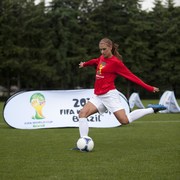 Photo courtesy of DePuy Mitek
Photo courtesy of DePuy Mitek
With the start of the new school year comes the beginning of fall sports. Athletes — both professionals and amateurs — are at risk for injuries if they do not properly warm up and practice injury prevention techniques.
Olympic athlete Alex Morgan knows what it is like to sustain a serious sports injury. In her senior year of high school, she tore her anterior cruciate ligament, or ACL.
The gold medal soccer player has teamed up with DePuy Mitek to promote sports injury prevention. She and Bert Mandelbaum, M.D., Medical Director for the U.S. World Cup Team, talked to EmpowHER about preventing sport injuries. They gave tips for athletes of all ages, including the parents of young athletes.
EmpowHER: You tore your ACL your senior year of high school. What did you learn from that experience?
Alex: Unfortunately, I tore my ACL my senior year of high school and was unable to play for the rest of the year. It was tough both physically and emotionally.
After surgery and physical therapy, I was lucky to be back on the field five months later, playing soccer in a brace. I wish I had known more about injury prevention warm-ups — such as FIFA 11+ — when I was younger.
EmpowHERWhat kinds of sports-related injuries do you commonly see? How can they be prevented?
Dr. Mandelbaum: In my role as one of the lead physicians for the U.S. National Soccer Teams and in my medical practice, I’ve worked with many athletes who have experienced sports injuries, such as the ACL tear that Alex suffered.
In addition, studies have shown that 45,000 female athletes in the U.S. — aged 19 and younger — experience a sprain or strain of the anterior cruciate ligament (ACL) of the knee each year (1), which is four to six times greater in females than males (2).
Research also shows that up to 35 percent of competitive soccer players (as defined by playing 2-3 games per week plus practice) suffer cartilage lesions or damage to the surface of the knee, compared to 5-11 percent of the general population (3).
These statistics show the great need to raise awareness of sports injury prevention among young athletes to minimize the risks and optimize the benefit of sport.
In addition to ACL injuries, ankle sprains are common and most importantly, prevention can be helped with preparation and planning using the FIFA 11+ program.
Unfortunately, injuries suffered as a result of playing sports may have long-lasting consequences — such as discomfort, pain and even arthritis — for years to come. Even less serious injuries can keep an athlete off the field for quite some time.
When injuries do occur, it is important for young athletes, their parents and coaches to seek appropriate medical attention. This is extremely important as the amount of time between an injury and its treatment has a direct impact on recovery time (3).
EmpowHER: With several sports starting up this month, what injury prevention tips do you have for kids and adults?
Alex: Warm-up and recovery are both really important to me and something I stress to young athletes and their parents to make sure to incorporate into their routine. As an athlete, you have to take care of your body and one of the best ways you can do that is by warming up properly.
FIFA 11+ is a program designed to help young athletes warm-up properly by teaching techniques that help train your body to become more resistant to injuries, such as how to properly jump or land. For example, training certain muscles can help stabilize joints and training for balance makes athletes less susceptible to falls.
Because a proper warm-up is so important, I’m working with DePuy Mitek, an official sports medicine sponsor of the 2014 FIFA World Cup™, on a Sports Injury Prevention Program.
We are visiting 16 U.S. cities to provide educational clinics for young athletes and to share injury prevention tips and techniques based on the FIFA 11+ program. These exercises are an important part of protecting the hard work I’ve done, and I’m excited to educate athletes, parents and coaches about FIFA’s 11+.
In addition to the clinics, interactive online resources can be found on the program’s Facebook page http://www.facebook.com/SportsInjuryPreventionProgram/
EmpowHER: What are common mistakes individuals make when they are warming up?
Dr. Mandelbaum: As we head into a new school year and many young athletes gear up for playing fall sports, it is especially important for young athletes, their parents and coaches to put an emphasis on sports injury prevention to keep these young players as safe and injury free as possible.
According to the CDC, more than half of all sports injuries in children are preventable. Some common mistakes people make when they warm up include not warming up for long enough and not doing proper exercises to get your body ready for practice or a game.
That’s why I’m happy to work with DePuy Mitek and the Sports Injury Prevention Program, including FIFA’s 11+ — a set of injury prevention warm-up techniques — to let young athletes know the importance of such practices. It is easy, safe and simple to do — just 20 minutes of your time, twice a week.
Using a proper warm-up — such as FIFA’s 11+ — helps get your body prepared for athletic activities. The FIFA 11+ program focuses on running, strength, plyometrics — which are exercises that train muscles for fast and powerful movements — and balance.
Together, these warm-up exercises help prepare the body for the strenuous level of activity and impact it will experience during practice and competition. In fact, several published studies have been conducted to evaluate FIFA 11+’s effectiveness and found that teams performing the 11+ at least twice a week had 30-50 percent fewer injured players (5)(6).
EmpowHER: What should parents know about injury prevention? And what can they do?
Alex: The stat that sticks out to me is that, according to the CDC, more than half of all sports injuries in children are preventable, which is why we are raising awareness of injury prevention. Parents can encourage their children to start every practice or game with a warm-up.
FIFA 11+, for example, is recommended to be performed for 20 minutes as a standard warm-up at the start of each training session at least twice a week. Prior to games, only the FIFA 11+ running exercises should be performed.
Other ways parents can keep their kids healthy is to make sure they are hydrated, well-nourished and get plenty of rest.
Even the most careful athletes will sometimes face a sports-related injury, and it is important to seek appropriate attention from a physician for injuries. I have seen so many of my fellow athletes injure themselves while playing sports and I know how hard recovering from an injury can be.
That’s why I hope more young athletes — and their parents and coaches — will put a priority on injury prevention and warming up, to protect themselves.
References
Interview with Alex Morgan and Bert Mandelbaum, M.D. Email. 17 September 2012.
(1) Centers for Disease Control and Prevention. Morbidity and Mortality Weekly Report. September 29, 2006 / Vol. 55 / No. 38.
http://www.cdc.gov/mmwr/preview/mmwrhtml/mm5538a1.htm
(2) Renstrom P. et al. Non-contact ACL injuries in female athletes: an International Olympic Committee current concepts statement.
Br J Sports Med. 2008 Jun;42(6):394-412.
http://www.ncbi.nlm.nih.gov/pubmed/18539658
(3) Bekkers JEJ, et al. Cartilage Repair in Football (Soccer) Athletes: What Evidence Leads to Which Treatment? A Critical Review of the Literature. Cartilage. 2012;3(Suppl. 1).
http://intl-car.sagepub.com/content/3/1_suppl/43S.abstract
(4) Junge A, Lamprecht M, Stamm H, Hasler H, Bizzini M, Tschopp M, Reuter H, Wyss H, Chilvers C, Dvorak J. Country-wide campaign to prevent football injuries in Swiss amateur players. Am J Sports Med 2010 Oct 17.
http://www.f-marc.com/downloads/scientific_papers/countrywide.pdf
(5) Soligard T, Myklebust G, Steffen K, Holme I, Silvers H, Bizzini M, Junge A, Dvorak J, Bahr R, Andersen TE. Comprehensive warm-up programme to prevent injuries in young female footballers: cluster randomised controlled trial. BMJ 2008;337:a2469.
http://www.bmj.com/content/337/bmj.a2469
Reviewed September 19, 2012
by Michele Blacksberg RN
Edited by Jody Smith






Add a Comment2 Comments
Great article. The return of fall sports and youth athletes back on the field means millions of youngsters will experience an injuryeven before their sports season is officially over. Youth sports account for almost four million emergency room visits each year.
October 19, 2012 - 4:23amThis Comment
Great article. More parents need this type of education and wish the local soccer leagues provided more of this to the parents and children.
Marielaina Perrone DDS
October 7, 2012 - 1:30pmThis Comment